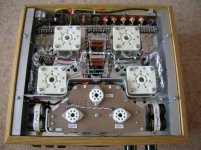The cables the Op was asking about were the 250v dc B+ interconnects between power supply board and each channel terminals and the 6.3VAC heater supply
I thought recommending 1KV rating for this and 16awg for the heaters was a bit overblown.
I thought recommending 1KV rating for this and 16awg for the heaters was a bit overblown.
In a nut shell,
I would use 600V on the b+..the heater cables cross section is dependant on cable type, with silver plated wire the cross section is higher current rating with smaller cross section and easier to twist. On preamp tubes I use 1mm (total physical size) It also depends if I am lifting the heater supply so the voltage rating is dependant on circuit. On an Aikido it could be 70-100V lift on the heater wiring. so the heater wiring would not be 6.3v...
For power tubes I double up and twist..even at high current..The wires across the PCB in the picture are heater solid core silver plated PTFE. Not everyone would want to do this so just using a size you can manage and doesn't break is the best way. You could run very small cables for preamp tubes..its the start up current that could be an issue with power tubes or a short inside a twisted pair that is not fused for a rectifier tube or power tubes burning out the power Tx winding. How many people fuse their heater windings?
The link is just an example you can buy small lengths from HIFI shops etc..
So I'm more concerned that I don't get a short between the twisted wire (insulation fail) as well as the size of cable and insulation type/voltage.
Just an eg
High Temperature Wires | Electro Cables
Regards
M. Gregg
I would use 600V on the b+..the heater cables cross section is dependant on cable type, with silver plated wire the cross section is higher current rating with smaller cross section and easier to twist. On preamp tubes I use 1mm (total physical size) It also depends if I am lifting the heater supply so the voltage rating is dependant on circuit. On an Aikido it could be 70-100V lift on the heater wiring. so the heater wiring would not be 6.3v...
For power tubes I double up and twist..even at high current..The wires across the PCB in the picture are heater solid core silver plated PTFE. Not everyone would want to do this so just using a size you can manage and doesn't break is the best way. You could run very small cables for preamp tubes..its the start up current that could be an issue with power tubes or a short inside a twisted pair that is not fused for a rectifier tube or power tubes burning out the power Tx winding. How many people fuse their heater windings?
The link is just an example you can buy small lengths from HIFI shops etc..
So I'm more concerned that I don't get a short between the twisted wire (insulation fail) as well as the size of cable and insulation type/voltage.
Just an eg
High Temperature Wires | Electro Cables
Regards
M. Gregg
Attachments
Last edited:
A simple tip,
When using PVC wire you can put a small piece of heat shrink over the pvc insulation before you solder its stops shrink back and the PVC melting exposing the conductor..its a useful way to mark cables using yellow heat shrink and black indelible pen..
Regards
M. Gregg
When using PVC wire you can put a small piece of heat shrink over the pvc insulation before you solder its stops shrink back and the PVC melting exposing the conductor..its a useful way to mark cables using yellow heat shrink and black indelible pen..
Regards
M. Gregg
Agree entirely.Its important to remember the possible shock risk from the two ends of the 260-0-260 <<
Ie its important to be aware of the maximum potential within any chassis.
Not just to ground. Including +/- Rails on DC.
So the maximum potential in equipment is the maximum potential between any two points that could be measured. (not referenced to ground)
I twist all AC power cables (within chassis)..each to their own I guess.
Regards
M. Gregg
Just to add - for the AC wiring on the 260-0-260 transformer connection, the peak voltage between the two 260 volt terminals will be about 735 volts when the transformer is loaded but could easily be 10% - 15% greater than this (up to 845 volts) when not significantly loaded.
It is easy to lose sight of the potential differences involved if only looking at the nominal B+ voltage.
Yeah, just does not have any bearing on the rating of the post rectifier wiring.
BTW I use 600v rated wire post rectifier
BTW I use 600v rated wire post rectifier
If practical, the PT wires 260-CT-260 should be twisted, as they would likely be carrying the noisiest hum current signal in the amp depending on the rectifier and filter type used, and they certainly carry high AC mains voltage, so they are a concern for coupling to anything sensitive nearby.
- Status
- Not open for further replies.
- Home
- Design & Build
- Construction Tips
- Twisted power cables

